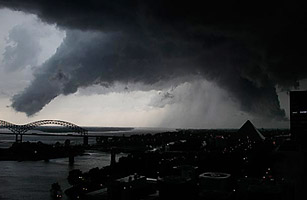
A line of storms crosses the Mississippi River as severe weather threatens the central states. Memphis, Tennessee, May 25, 2011. Lance Murphey / AP
As the middle of the country weathers a truly historic string of tornadoes—see TIME’s David Von Drehle’s moving story from Joplin, Mo.—another battle has opened up over climate change’s possible role in these record-breaking disasters. For many environmentalists, the twisters of 2011 are an ominous sign of things to come—and another Katrina, chance for greens to press for action on reducing carbon emissions. In the Washington Post, 350.org head Bill McKibben satirized those who dismissed any connection between the cyclones and human-caused warming:
Caution: It is vitally important not to make connections. When you see pictures of rubble like this week’s shots from Joplin, Mo., you should not wonder: Is this somehow related to the tornado outbreak three weeks ago in Tuscaloosa, Ala., or the enormous outbreak a couple of weeks before that (which, together, comprised the most active April for tornadoes in U.S. history). No, that doesn’t mean a thing.
The problem—as even firm greens like Joe Romm of Climate Progress acknowledge—is that the links between warming temperatures and more powerful and numerous tornadoes are tenuous at best, even more so than for extreme weather events like hurricanes or floods. Judith Curry of Georgia Tech—the “climate heretic” herself—argues that there has actually been a downward trend in strong tornadoes since the U.S. began keeping records in the 1950s, and that it’s a fool’s errand to try to use the recent string of storms as a reason for immediate action on climate change:
We need to look at each type of extreme event, in different regional locations, and then interpret them in the context of the local historical records, and then cumulatively in context with the teleconnection weather regimes and multi-decadal oscillations. Once we’ve done that and then find an upward trend in frequency and/or intensity that cannot be explained by problems with the data record or natural climate variability or weather roulette, THEN lets talk about the potential impact of global warming.
That’s a logical argument, but the trouble is that it will take years or even decades to build the scientific models that would allow us to actually attribute individual weather events to manmade global warming. This will be even tougher with tornadoes, where the historical records are less well understood than other extreme weather events. (Nor does it help that the historical records for tornadoes are extremely sketchy, which makes it difficult to even identify any possible trends.) It took years of work for scientists for scientists in the journal Nature to pin increased flooding in the second half of the 20th century on global warming—and even then, as Andrew Revkin of the Dot Earth pointed out at the time, the science was still a little squishy.
Attribution is the holy grail of climate science, but it’s also an unrealistic one. By the time scientists could tell us for sure that greenhouse gases are causing an extreme weather event, it would be far too late for us to cut carbon emissions. Yet every time there’s a catastrophic weather event—the floods in Pakistan, the heat wave in Russia and now the tornadoes in the South—the debate cranks up again. (And it’s usually a debate that pins green against green—and climate skeptics use the noise as one more excuse to ignore the problem.) If anything, the argument is rooted in the unrealistic expectations that some environmentalists have about climate science. There’s a desire for firm red lines on climate, degrees of warming or concentrations of carbon that can be identified and used as speed limits to guide policy. As the Stanford political scientist David Victor makes clear in his aptly named new book Global Warming Gridlock, however, those limits—like just about all environmental regulations—have as much or more to do with politics as they do with science. Climatologists can paint a picture of a warmer future, but they can’t tell us exactly how it will unfold—or exactly what carbon target we need to hit to stay safe. (And safe, after all, is a subjective condition.)
But guess what? It doesn’t matter. We already know more than enough about climate change to fear it. We know enough to embark on the long-term changes to our energy economy needed to reduce carbon emissions and blunt the impact of what no less than the Department of Defense has called a major threat to national security. That doesn’t mean we should focus on greenhouse gases to the exclusion of all the other threats we face, natural and manmade (if we can still tell the difference). The risk of extreme weather is one of many reasons we need to cut carbon, but improving detection and disaster resilience will save far more lives and far more quickly than going solar or becoming more energy-efficient. As long as we’re thinking about tornadoes or cyclones or hurricanes or floods, adaptation needs to be kept in the foreground—the disaster gap between poor countries and rich ones shows what a difference preparation can make in human lives. But we can’t escape the need to change the way we use energy—for disasters, for nature and for countless other reasons. There shouldn’t be any debate about that.
And if there is—leave me off the email chain.


